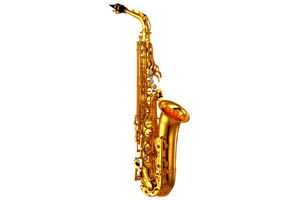INSTRUMENTS
Flute
Oboe & Bassoon
Clarinet
Saxophone
Horn
Trumpet
Trombone
Baritone & Tuba
Percussion
MUSIC READING
LINKS
PICTURES
SOUNDS
Brighton
Derby
Other
TEACHER INFO
HISTORY
I have always found it interesting that the
saxophone is one of the few instruments that can be traced back to one
individual. Adolphe
Sax, a Belgian inventor,
patented his family of saxophones in 1846. This invention combined the bore and fingering
patterns of the oboe with the single reed of the clarinet, producing the tonal qualities
of neither.
The instruments fit well into bands, for their sound blends well with brass and woodwind instruments; their application to the orchestra has been more limited, because saxophones tend to dominate the varied tonal characteristics of that ensemble. Saxophones are made in seven sizes and pitch levels, spanning the entire spectrum of wind-instrument pitches. The most common saxophones heard and seen today are the alto and tenor saxophones. Also seen are soprano and baritone models, although others exist but are rarely used.
Although composers of "classical" music have written for it, the instrument is more commonly heard in jazz and popular music.
PROBLEM SOLVING
I recommend that you get started with a teacher so that you learn to hold your saxophone correctly, and make your first sounds correctly. If you get home and still have problems, though, these hints might help.
If you're just getting a rough squawk, you should try putting less mouthpiece in your mouth. You could also shape your mouth in more of an "oh" shape. If you're using a hard reed, you might want to try a softer one.
Is your sound wobbly? Probably your upper lip is on the mouthpiece. It should be your top teeth touching, instead.
If the sound is choked then try putting more mouthpiece in your mouth and relaxing your mouth a bit. Make sure your mouth is in an "oh" shape.
If it's very hard to blow you should either use a softer reed or the pads on the instrument may leak. In that case, you'd need it repaired.
If the sound is very nasal, you could try using faster air, or a harder reed.
LINKS
HERE IS A LINK that could be helpful for
beginners:
www.8notes.com
Classic Saxophone Online
Sax On The Web
Altissimo - The Complete Saxophone
Website